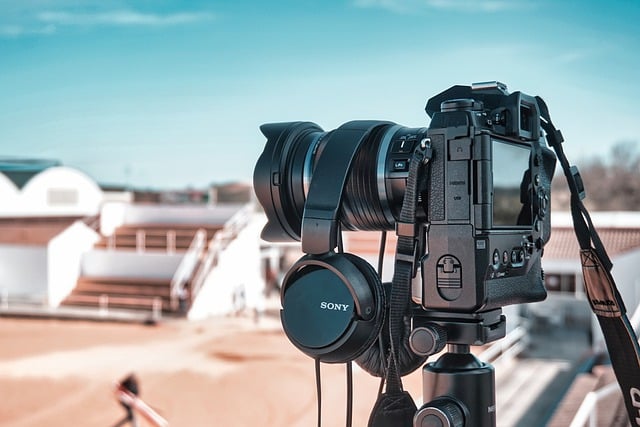Converting DivX to AVI offers a balance between video quality and file size optimization. The DivX Codec's superior compression ensures high-fidelity visuals at reduced bitrates, ideal for streaming or storage. Adjusting encoding parameters like bitrate (CRF) allows users to fine-tune picture clarity while managing file sizes. A reliable video converter supporting DivX and AVI formats makes the process simple, preserving image quality for convenient, compact video enjoyment.
Experience crystal-clear images with DivX codec—a game-changer for video enthusiasts. This article explores how to achieve exceptional image quality at remarkably low bitrates, perfect for efficient file sharing. We’ll guide you through ‘Understanding Bitrates and Image Quality’, the benefits of ‘Why Choose DivX Codec?’, and the advantages of converting to AVI format. Learn to optimize settings for optimal results and follow our step-by-step guide to convert DivX to AVI effectively.
Understanding Bitrates and Image Quality

Bitrate, in simple terms, refers to the amount of data used to represent a certain segment of an image or video. It essentially determines the quality and size of the media file. When encoding videos, like converting DivX to AVI, setting lower bitrates can result in smaller file sizes but may compromise image clarity and detail.
On the other hand, higher bitrates allow for more data to be stored per frame, leading to sharper images and smoother playback. However, this comes at the cost of larger file sizes. Balancing these factors is key to achieving exceptional image quality while keeping file sizes manageable, especially in streaming or storage scenarios where efficient data compression is crucial.
Why Choose DivX Codec?

DivX Codec stands out for its remarkable ability to deliver high-quality video compression, ensuring exceptional image quality even at low bitrates. This makes it a top choice for users looking to optimize their video files while maintaining excellent visual fidelity. The codec’s efficiency is particularly beneficial when converting DivX to AVI, allowing for smaller file sizes without sacrificing detail or clarity.
Choosing DivX Codec offers several advantages in various scenarios, especially when dealing with limited storage space or streaming over the internet. Its advanced compression techniques ensure that your videos look crisp and clear, making it ideal for everything from personal entertainment to professional productions that demand top-tier visual quality despite size constraints.
The Advantages of Converting to AVI

Converting your videos from DivX to AVI format offers several advantages, especially when prioritizing image quality while maintaining small file sizes. AVI (Audio Video Interleave) is a popular and widely supported container format known for its versatility and compatibility across various devices and platforms. One of the key benefits is that it preserves high-quality visuals even at low bitrates, ensuring your videos look crisp and clear.
This conversion process allows for efficient compression without significant loss of detail, making it ideal for streaming or sharing online where bandwidth constraints might be an issue. By choosing AVI, you can ensure your videos maintain their integrity while reducing file sizes, which is beneficial for storage and faster transmission.
Optimizing Settings for Best Results

When optimizing video settings for the best results, especially when converting DivX to AVI, understanding the balance between quality and file size is key. Lower bitrates can significantly enhance storage efficiency, making videos easier to stream or share online. However, this may come at the cost of image clarity. To mitigate this, adjust encoding parameters like bitrate, resolution, and frame rate. Increasing the bitrate will generally improve picture quality but also increase file size, so finding the right balance is crucial.
For instance, setting a higher constant bitrate (CRF) during conversion can maintain detail while keeping file sizes manageable. Lower CRF values retain more data, resulting in sharper images but larger files. Experimenting with different settings allows you to achieve the desired quality without compromising on storage space. Remember, the goal is to strike a suitable compromise for your specific use case when converting DivX to AVI.
Step-by-Step Guide: Convert DivX to AVI Effectively

Converting DivX to AVI is a straightforward process that allows users to enjoy high-quality videos with efficient file sizes. Here’s a step-by-step guide to help you through the conversion:
1. Choose a Reliable Conversion Tool: Select a reliable video converter that supports DivX and AVI formats. There are numerous options available online, both free and paid. Make sure the tool offers excellent image quality preservation at low bitrates.
2. Import DivX File: Open your chosen converter and navigate to the “Add Files” or “Import” section. Locate and select your DivX video file from your computer’s files system. The converter should detect and load the file for processing.
3. Select AVI as Output Format: In the conversion settings, look for an “Output Format” or “Destination” option. Choose “AVI” from the list of available formats. This ensures that your converted video will be in the AVI format, maintaining exceptional image quality.
4. Adjust Settings if Necessary: Depending on your converter and specific needs, you might have the option to fine-tune settings like resolution, bitrate, and encoding method. For optimal results at low bitrates, select appropriate values tailored for efficient video storage without sacrificing quality.
5. Start Conversion Process: Once you’re satisfied with the settings, initiate the conversion process. The converter will process your DivX file and create an AVI version, preserving the original quality while offering a smaller file size.
6. SaveConverted File: After successful conversion, locate the output AVI file in the specified save directory or where you directed the converter to save it. Now, you can enjoy your high-quality video in a convenient and compact format.
Converting videos from DivX to AVI format offers a remarkable balance between file size and image quality. By leveraging the DivX codec’s ability to provide exceptional clarity at low bitrates, users can enjoy crisp, detailed visuals while maintaining smaller file sizes. The process, as outlined in this guide, ensures optimal settings for best results, making it an efficient and effective way to convert videos without compromising on visual fidelity. Whether for sharing or archival purposes, converting DivX to AVI is a smart choice for preserving and distributing high-quality video content.
